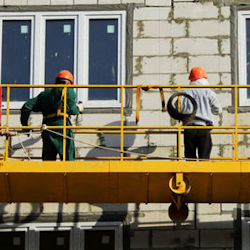Using Adjustable-Suspension Scaffolds
Before you use an adjustable-suspension scaffold, you need to know the engineering principles for anchoring and suspending the scaffold, how to rig the scaffold, how to operate the hoist, how to work safely from the scaffold, and what to do in an emergency.
In addition, a competent person must examine all direct connections that are part of the system and confirm that the connections will support the platform loads. You must also wear a personal fall-arrest system to protect yourself if a connection fails. Most fatal falls from suspended platforms result when a support rope fails and workers aren't wearing personal fall-arrest gear.
Requiring Fall-Protection Systems
If you work on an adjustable-suspension scaffold more than 10 feet above a lower level, you must be protected from falling.
- Single-point and two-point adjustable-suspension scaffolds: Personal fall-arrest systems and guardrail systems are required on single-point or two-point adjustable-suspension scaffolds. The top edge of guardrail must be between 36 inches and 45 inches above the platform surface. (The top edge can exceed 45 inches when necessary.)
- Boatswain's chairs: Personal fall-arrest systems are required for workers who use boatswain's chairs.
- Multipoint adjustable-suspension scaffolds: Personal fall-arrest systems and guardrail systems are required on multipoint adjustable-suspension scaffolds. The top edge of the guardrail must be between 36 inches and 45 inches above the platform surface. (The top edge can exceed 45 inches, when necessary.)
Descent-Control Devices
A descent-control device lets you descend a primary support rope - typically from a boatswain's chair - then lock the device when you reach the work area. The device works by friction, engaging the support rope and controlling the descent speed. Most workers start from the roof and work down the face of the building. When they reach the ground, they remove the descent equipment from the support rope and return to the roof for another drop.
Why Falls Occur
Most adjustable-suspension scaffold malfunctions that cause falls result from failure of the primary support rope or a supporting anchor, not the descent device. Support ropes fail because workers don't inspect them regularly or they misuse them. Anchors fail when workers simply assume they are secure. Descent devices, support ropes, and anchors rarely fail when workers know how to use them.
Knowledge Check Choose the best answer for the question.
4-9. Most suspended scaffold falls result from _____.
You forgot to answer the question!

